Design for Sustainability by Additive Manufacturing: A Study of PLA-Based Door Handle Redesign
Abstract
1. Introduction
2. Materials and Methods
2.1. Materials
2.2. Degradation Tests and Mechanical Characterization
2.3. Redesign Principles
3. Results and Discussion
3.1. Coatings Evaluation
3.2. Mechanical Properties
3.3. Redesign of Door Handle
3.4. Long-Life Manufacturing: Final Considerations
4. Conclusions
- UV-B exposure affected color stability, particularly in uncoated and green PLA samples, highlighting the critical need for UV-resistant coatings to preserve aesthetic quality in outdoor applications, whereas thermal aging exhibited only a minor effect across all samples.
- Prolonged UV-B exposure reduced the elastic modulus and elongation at break due to photo-oxidation and the formation of micro-cracks, indicating that surface protection is vital for mechanical resilience in exterior applications. In contrast, thermal cycling had a lesser impact on mechanical properties, except for a noticeable reduction in elongation at break. Overall, both UV-B and thermal aging led to a clear reduction in ductility, with UV-B exposure also causing an increase in tensile strength but further compromising ductility.
- Through the use of lattice infill optimization and protective coatings, the redesigned lever, pull, and drawer handles achieved an optimal balance of weight reduction, strength, aesthetics, and ergonomics, while additive manufacturing further enabled lightweight, repairable, and customizable designs that foster user engagement, emotional attachment, and extended product life in alignment with LLM principles.
Author Contributions
Funding
Data Availability Statement
Acknowledgments
Conflicts of Interest
Abbreviations
| and | Chromaticity |
| Total color variation | |
| Lightness | |
| AM | Additive manufacturing |
| CAGR | Compound annual growth rate |
| FDM | Fused deposition modeling |
| G | Green |
| LLM | Long-life manufacturing |
| N | Untreated or uncoated |
| PLA | Polylactic acid |
| Ref | Reference color |
| TM | Thermal cycle |
| UV-B | Ultraviolet B radiation |
| W | White |
References
- Montalvo, C.; Rietveld, E.; Peck, D. A Longer Lifetime for Products: Benefits for Consumers and Companies. June 2016. Available online: https://www.researchgate.net/publication/305043294 (accessed on 1 May 2025).
- ASTM F2792-12a; Terminology for Additive Manufacturing Technologies. ASTM: West Conshohocken, PA, USA, 2012. [CrossRef]
- Din, I.U.; Kulkarni, S.S.; Khan, K.A. Thermo-Mechanical viscoelastic Characterization and Modeling of 4D Printed Shape Memory Polymers. Polym. Test. 2025, 143, 108708. [Google Scholar] [CrossRef]
- Storck, J.L.; Ehrmann, G.; Uthoff, J.; Diestelhorst, E.; Blachowicz, T.; Ehrmann, A. Investigating Inexpensive Polymeric 3D Printed Materials Under Extreme Thermal Conditions. Mater. Futur. 2022, 1, 015001. [Google Scholar] [CrossRef]
- Guessasma, S.; Belhabib, S.; Nouri, H. Thermal Cycling, Microstructure and Tensile Performance of PLA-PHA Polymer Printed Using Fused Deposition Modelling Technique. Rapid Prototyp. J. 2020, 26, 122–133. [Google Scholar] [CrossRef]
- Djurović, S.; Lazarević, D.; Ćirković, B.; Mišić, M.; Ivković, M.; Stojčetović, B.; Petković, M.; Ašonja, A. Modeling and Prediction of Surface Roughness in Hybrid Manufacturing–Milling After FDM Using Artificial Neural Networks. Appl. Sci. 2024, 14, 5980. [Google Scholar] [CrossRef]
- Palić, N.; Slavković, V.; Jovanović, Ž.; Živić, F.; Grujović, N. Mechanical Behaviour of Small Load Bearing Structures Fabricated by 3D Printing. Appl. Eng. Lett. 2019, 4, 88–92. [Google Scholar] [CrossRef]
- Tümer, E.H.; Erbil, H.Y. Extrusion-Based 3d Printing Applications of PLA Composites: A Review. Coatings 2021, 11, 390. [Google Scholar] [CrossRef]
- Podzorova, M.V.; Tertyshnaya, Y.V.; Pantyukhov, P.V.; Popov, A.A.; Nikolaeva, S.G. Influence of Ultraviolet on Polylactide Degradation. In Proceedings of the International Conference on Advanced Materials with Hierarchical Structure for New Technologies and Reliable Structures, Tomsk, Russia, 9–13 October 2017; American Institute of Physics Inc.: Melville, NY, USA, 2017; Volume 1909. [Google Scholar] [CrossRef]
- Brown, M.H.; Badzinski, T.D.; Pardoe, E.; Ehlebracht, M.; Maurer-Jones, M.A. UV Light Degradation of Polylactic Acid Kickstarts Enzymatic Hydrolysis. Acs Mater. 2024, 4, 92–98. [Google Scholar] [CrossRef]
- Lanzotti, A.; Martorelli, M.; Maietta, S.; Gerbino, S.; Penta, F.; Gloria, A. A Comparison Between Mechanical Properties of Specimens 3D Printed with Virgin and Recycled PLA. Procedia Cirp 2019, 79, 143–146. [Google Scholar] [CrossRef]
- Hidalgo-Carvajal, D.; Muñoz, Á.H.; Garrido-González, J.J.; Carrasco-Gallego, R.; Montero, V.A. Recycled PLA for 3D Printing: A Comparison of Recycled PLA Filaments from Waste of Different Origins after Repeated Cycles of Extrusion. Polymers 2023, 15, 3651. [Google Scholar] [CrossRef]
- Bhagwat, S.V.; Shukla, V.V.; Trivedi, M.G.; Jha, A.; Padole, P. An Engineering Investigation of Bio-Polymers. Int. J. Mech. Prod. Eng. Res. Dev. 2019, 9, 348–355. Available online: https://www.researchgate.net/publication/335910272 (accessed on 1 May 2025).
- Corapi, D.; Morettini, G.; Pascoletti, G.; Zitelli, C. Characterization of a Polylactic Acid (PLA) Produced by Fused Deposition Modeling (FDM) Technology. Procedia Struct. Integr. 2019, 24, 289–295. [Google Scholar] [CrossRef]
- Zhang, C.; Rathi, S.; Goddard, J.; Constantine, K.; Collins, P. The Effect of UV Treatment on the Degradation of Compostable Polylactic Acid. J. Eng. Investig. 2013. [Google Scholar] [CrossRef] [PubMed]
- McKeown, P.; Jones, M.D. The Chemical Recycling of PLA: A Review. Sustain. Chem. 2020, 1, 1–22. [Google Scholar] [CrossRef]
- Beltrán, F.R.; Arrieta, M.P.; Moreno, E.; Gaspar, G.; Muneta, L.M.; Carrasco-Gallego, R.; Yáñez, S.; Hidalgo-Carvajal, D.; de la Orden, M.U.; Urreaga, J.M. Evaluation of the Technical Viability of Distributed Mechanical Recycling of PLA 3D Printing Wastes. Polymers 2021, 13, 1247. [Google Scholar] [CrossRef]
- Farah, S.; Anderson, D.G.; Langer, R. Physical and Mechanical Properties of PLA, and their Functions in Widespread Applications—A Comprehensive Review. Adv. Drug Deliv. Rev. 2016, 107, 367–392. [Google Scholar] [CrossRef]
- Bairagi, A.R.; Bisht, D.S. Design of Door Handle. Doctoral Dissertation, National Institute of Technology, Rourkela, India, 2014. Available online: https://core.ac.uk/download/pdf/53190392.pdf (accessed on 1 May 2025).
- Dorsey, O. Improvement In Door Holding Devices. 1878. Available online: https://patents.google.com/patent/US210764A/en (accessed on 1 May 2025).
- Deeb, J.M.; Danz-Reece, M.E.; Attwood, D.A. Ergonomic Solutions for the Process Industries; Gulf Professional Publishing, Elsevier: Amsterdam, The Netherlands, 2004. [Google Scholar]
- Paschoarelli, L.C.; Santos, R.; Bruno, P. Influence of Door Handles Design in Effort Perception: Accessibility and Usability. Work 2012, 41, 4825–4829. [Google Scholar] [CrossRef]
- Brass, C.; Glutz. GAI-Guide to Standards-10-BSEN1906-22-Final; Technical Report; Guild of Architectural Ironmongers: London, UK, 2012. [Google Scholar]
- Versha, V. Door Handles Market Size, Share, Growth and Industry Analysis. Technical Report, King Research. 2024. Available online: https://www.kingsresearch.com/door-handles-market-384 (accessed on 1 May 2025).
- Skyquest. Global Door Handles Market. Technical Report, Skyquest. 2024. Available online: https://www.skyquestt.com/report/door-handles-market (accessed on 1 May 2025).
- Varma, J.; Patankar, N. Door Handles Market: Market Analysis 2017–2030. Technical Report, Grand View Research. 2021. Available online: https://www.grandviewresearch.com/industry-analysis/door-handles-market (accessed on 1 May 2025).
- ISO-527-1; Determination of Tensile Properties. ISO: Geneva, Switzerland, 1993.
- ISO-527-2; Determination of Tensile Properties. ISO: Geneva, Switzerland, 1993.
- ASTMD4329-21; Practice for Fluorescent Ultraviolet (UV) Lamp Apparatus Exposure of Plastics. ASTM: West Conshohocken, PA, USA, 2021. [CrossRef]
- IEC 60068-2-14; International Standard Norme International Environmental Testing-Part 2-14. IEC: Geneva, Switzerland, 2023. Available online: https://standards.iteh.ai/catalog/standards/sist/3b4877b9-523b-4b80-b18b-6fc4d202bdc0/iec- (accessed on 1 May 2025).
- ASTM E805; Practice for Identification of Instrumental Methods of Color or Color-Difference Measurement of Materials. ASTM: West Conshohocken, PA, USA, 2022. [CrossRef]
- ASTMD4674-19; Practice for Accelerated Testing for Color Stability of Plastics Exposed to Indoor Office Environments. ASTM: West Conshohocken, PA, USA, 2019. [CrossRef]
- Othman, M.S.; Misran, M.F.R.; Khamisan, Z.H. Study on Mechanical Properties of PLA Printed using 3D Printer. J. Adv. Res. Appl. Mech. J. 2019, 59, 10–18. Available online: https://www.researchgate.net/publication/346713811 (accessed on 1 May 2025).
- Singh, J.; Goyal, K.K.; Kumar, R. Effect of Filling Percentage and Raster Style on Tensile Behavior of FDM Produced PLA Parts at Different Build Orientation. Mater. Today Proc. 2022, 63, 433–439. [Google Scholar] [CrossRef]
- Gunasekaran, K.N.; Aravinth, V.; Kumaran, C.B.; Madhankumar, K.; Kumar, S.P. Investigation of Mechanical Properties of PLA Printed Materials Under Varying Infill Density. Mater. Today Proc. 2021, 45, 1849–1856. [Google Scholar] [CrossRef]
- Hanon, M.M.; Dobos, J.; Zsidai, L. The Influence of 3D Printing Process Parameters on the Mechanical Performance of PLA Polymer and its Correlation with Hardness. Procedia Manuf. 2020, 54, 244–249. [Google Scholar] [CrossRef]
- Akhil, V.M.; Aravind, S.L.; Kiran, R.; Sivapirakasam, S.P.; Mohan, S. Experimental Investigations on the Effect of Infill Patterns on PLA for Structural Applications. Mater. Today Proc. 2022, 76, 636–639. [Google Scholar] [CrossRef]
- Yao, T.; Ye, J.; Deng, Z.; Zhang, K.; Ma, Y.; Ouyang, H. Tensile Failure Strength and Separation Angle of FDM 3D Printing PLA Material: Experimental and Theoretical Analyses. Compos. Part Eng. 2020, 188, 107894. [Google Scholar] [CrossRef]
- Sun, J.; Wang, X.; Zheng, H.; Xiang, H.; Jiang, X.; Fan, J. Characterization of the Degradation Products of Biodegradable and Traditional Plastics on UV Irradiation and Mechanical Abrasion. Sci. Total Environ. 2024, 909, 168618. [Google Scholar] [CrossRef]
- ACS. Thermal Shock Chambers. Technical Report, Angelantoni Technology for Life. 2014. Available online: https://www.acstestchambers.com/en/environmental-test-chambers/air-to-air-thermal-shock-chambers/ (accessed on 1 May 2025).
- Ramdé, T.; Ecco, L.G.; Rossi, S. Visual Appearance Durability as Function of Natural and Accelerated Ageing of Electrophoretic Styrene-acrylic Coatings: Influence of Yellow Pigment Concentration. Prog. Org. Coatings 2017, 103, 23–32. [Google Scholar] [CrossRef]
- Ecco, L.G.; Rossi, S.; Fedel, M.; Deflorian, F. Color Variation of Electrophoretic Styrene-acrylic Paints Under Field and Accelerated Ultraviolet Exposure. Mater. Des. 2017, 116, 554–564. [Google Scholar] [CrossRef]
- 3DPlink. Door Handle PA12. 2025. Available online: https://www.martinpierce.com/blog/category/casting+process (accessed on 1 May 2025).
- Ion, A.; Frohnhofen, J.; Wall, L.; Kovacs, R.; Alistar, M.; Lindsay, J.; Lopes, P.; Chen, H.T.; Baudisch, P. Metamaterial Mechanisms. In Proceedings of the 29th Annual ACM Symposium on User Interface Software and Technology (UIST ’16), ACM, Tokyo, Japan, 16–19 October 2016. [Google Scholar] [CrossRef]
- Chopra, S.; Pande, K.; Puranam, P.; Deshmukh, A.D.; Bhone, A.; Kale, R.; Galande, A.; Mehtre, B.; Tagad, J.; Tidake, S. Explication of Mechanism Governing Atmospheric Degradation of 3D-printed Poly(lactic acid) (PLA) with Different in-fill Pattern and Varying In-fill Density. Rsc Adv. 2023, 13, 7135–7152. [Google Scholar] [CrossRef]
- Shi, L.K.; Li, P.C.; Liu, C.R.; Zhu, J.X.; Zhang, T.H.; Xiong, G. An Improved Tensile Strength and Failure Mode Prediction Model of FDM 3D Printing PLA Material: Theoretical and Experimental Investigations. J. Build. Eng. 2024, 90, 109389. [Google Scholar] [CrossRef]
- Amza, C.G.; Zapciu, A.; Baciu, F.; Vasile, M.I.; Nicoara, A.I. Accelerated Aging Effect on Mechanical Properties of Common 3D-Printing Polymers. Polymers 2021, 13, 4132. [Google Scholar] [CrossRef]
- Moreno, E.; Beltrán, F.R.; Arrieta, M.P.; Gaspar, G.; Muneta, L.M.; Carrasco-Gallego, R.; Yáñez, S.; Hidalgo-Carvajal, D.; de la Orden, M.U.; Urreaga, J.M. Technical Evaluation of Mechanical Recycling of PLA 3D Printing Wastes. Proceedings 2021, 69, 19. [Google Scholar] [CrossRef]
- Hasan, M.R.; Davies, I.J.; Pramanik, A.; John, M.; Biswas, W.K. Potential of Recycled PLA in 3D Printing: A Review. Sustain. Manuf. Serv. Econ. 2024, 3, 100020. [Google Scholar] [CrossRef]
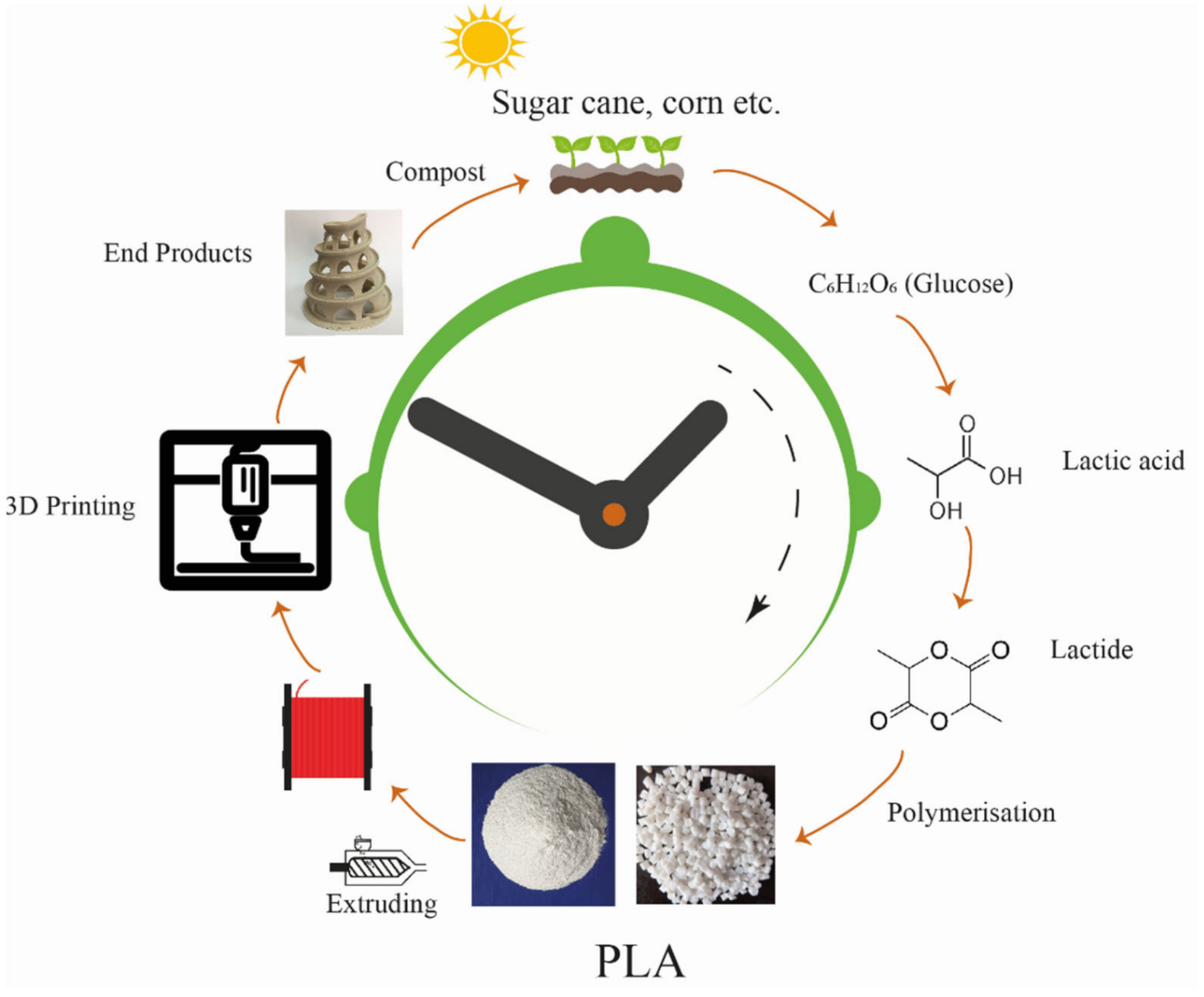
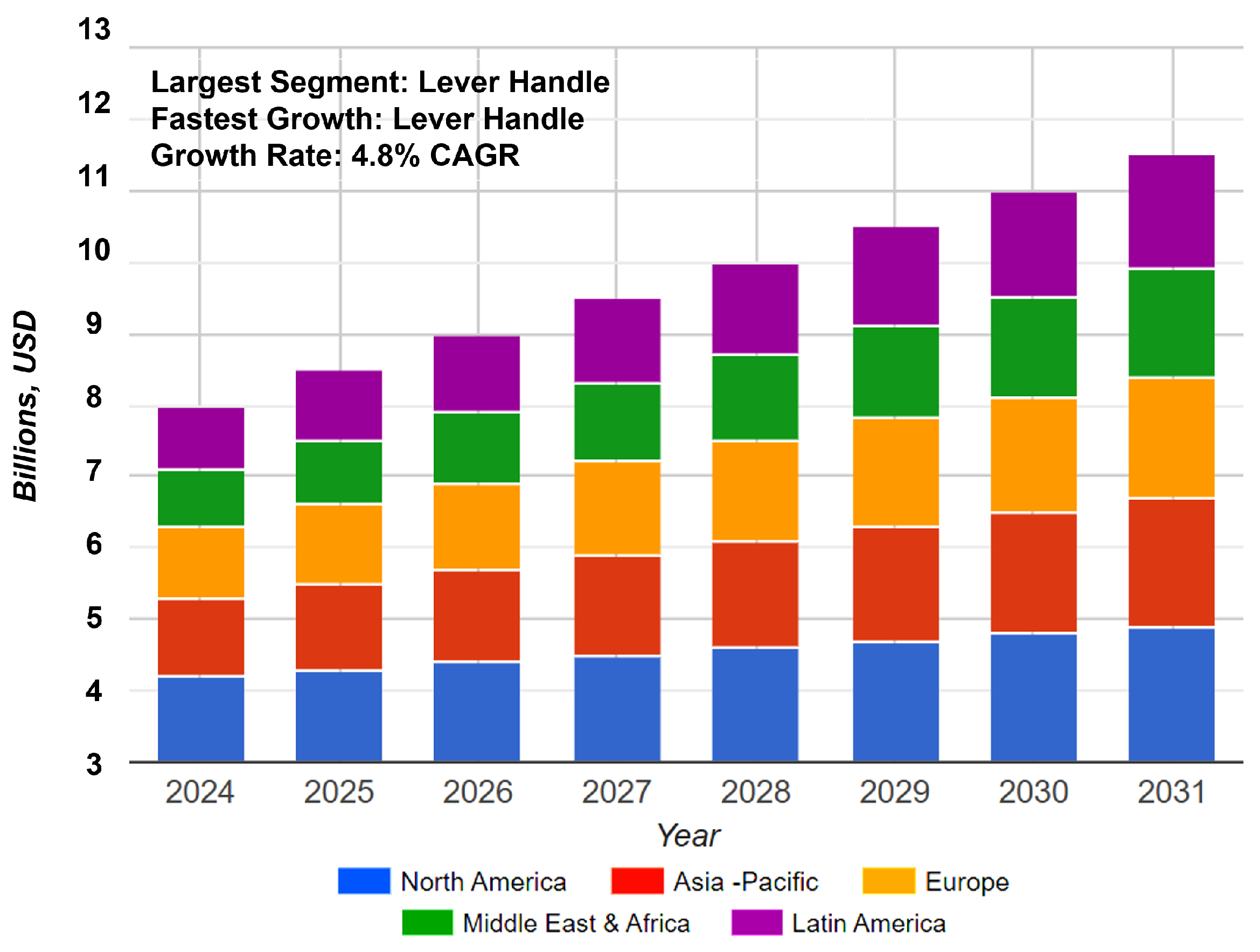

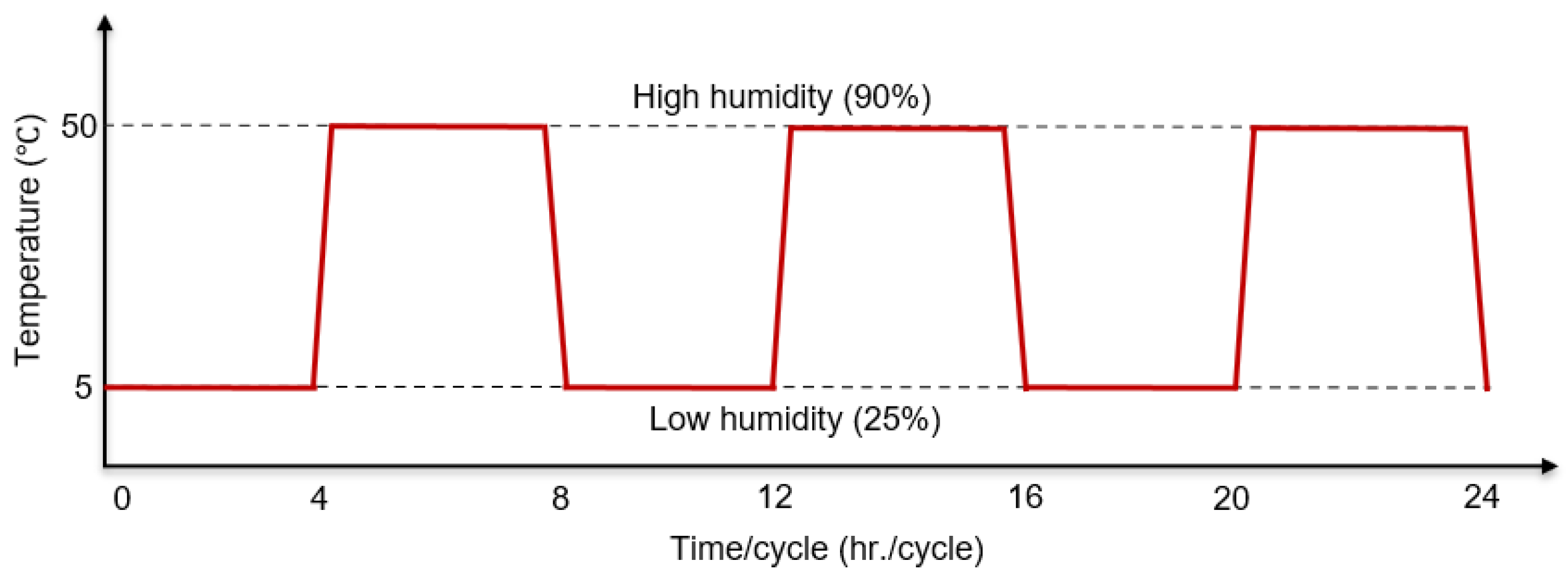
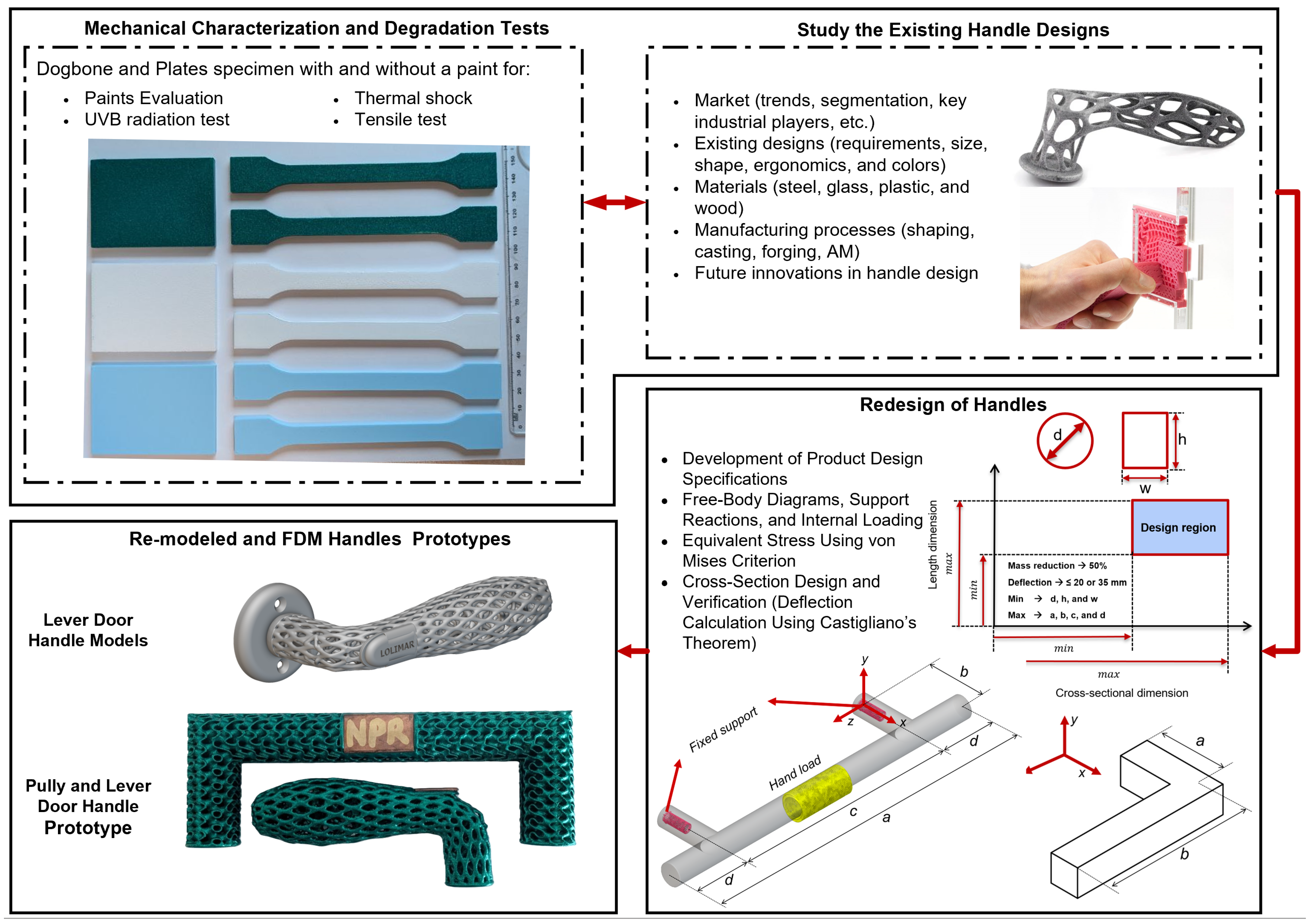
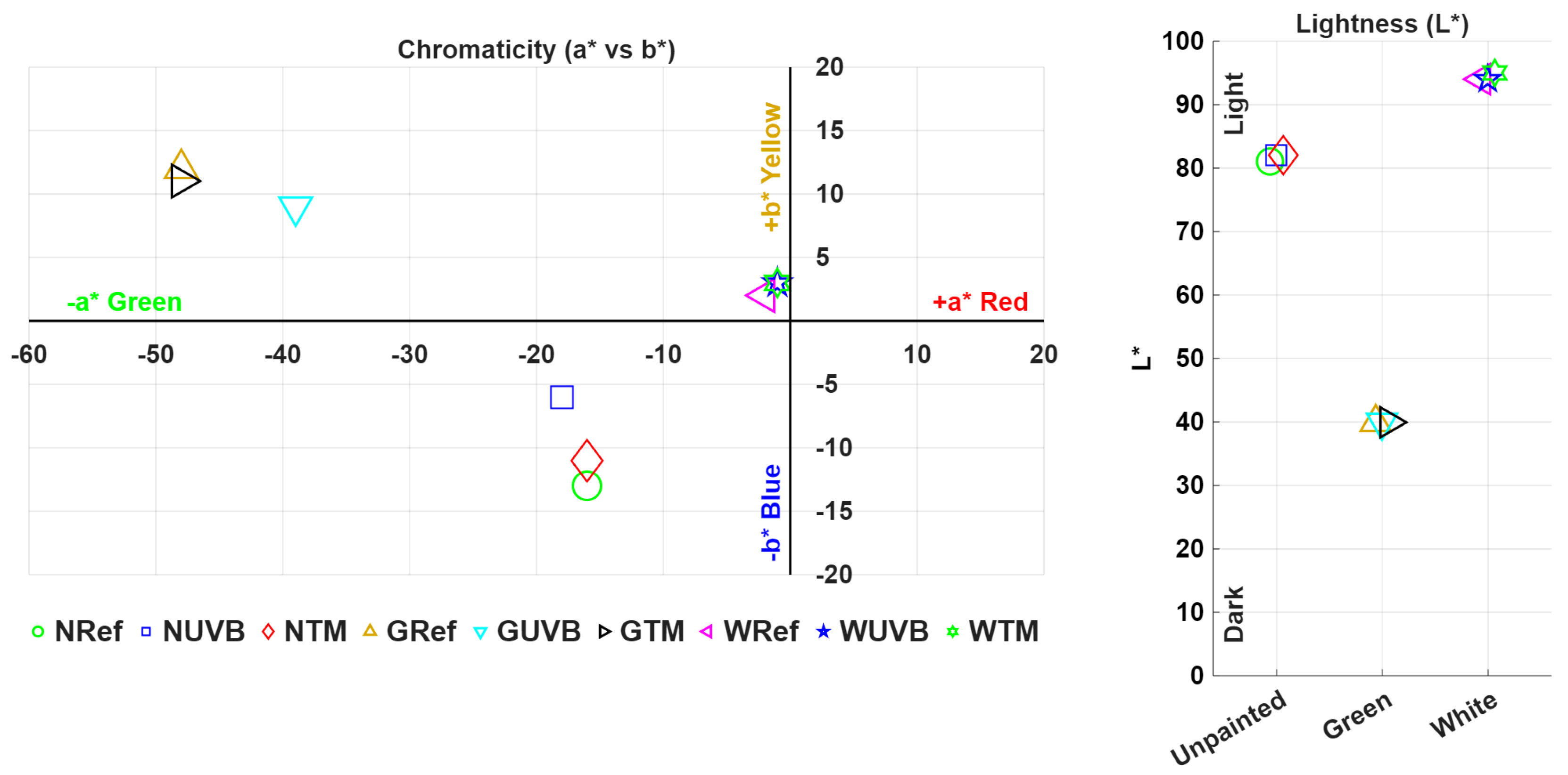
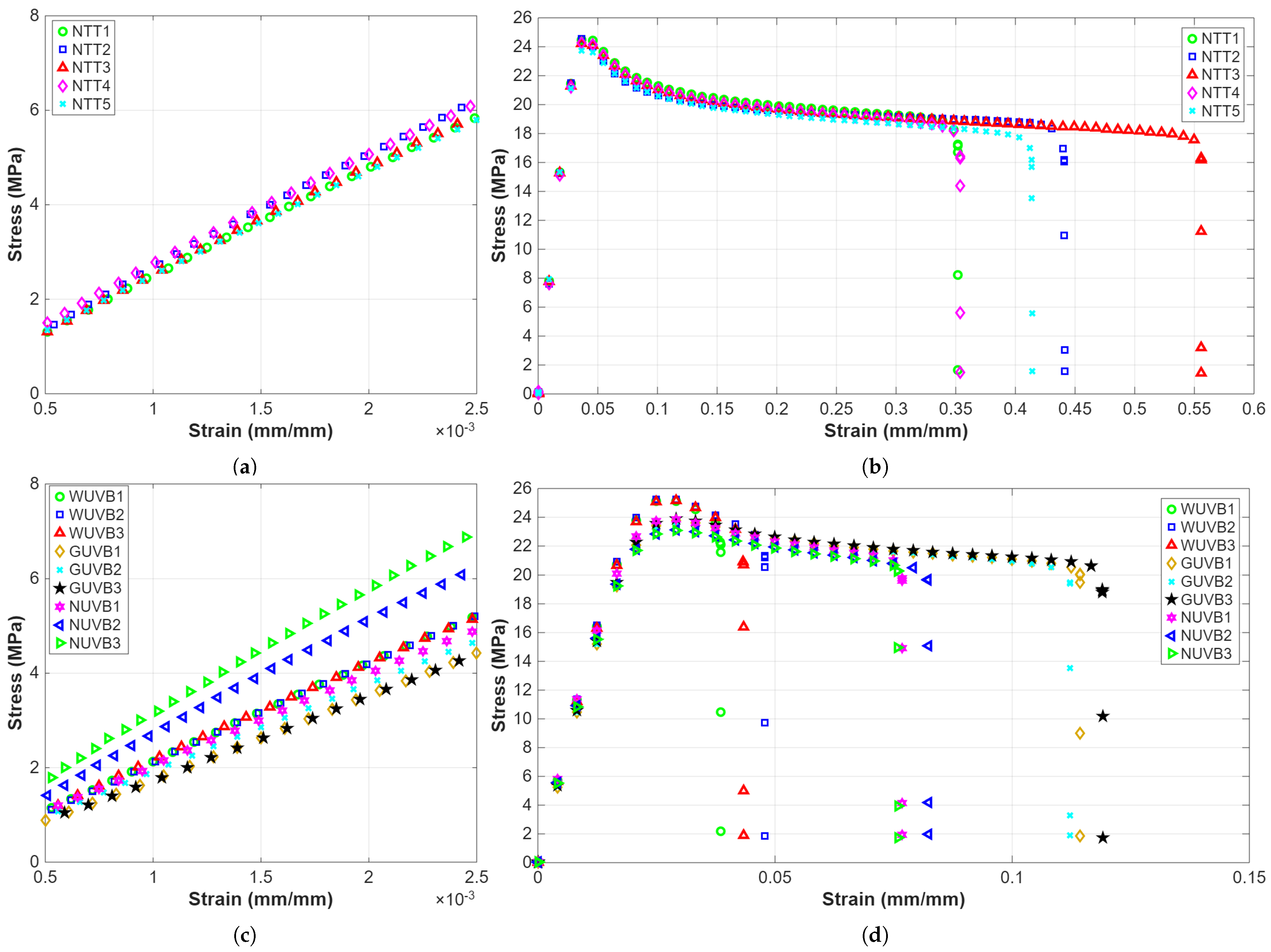
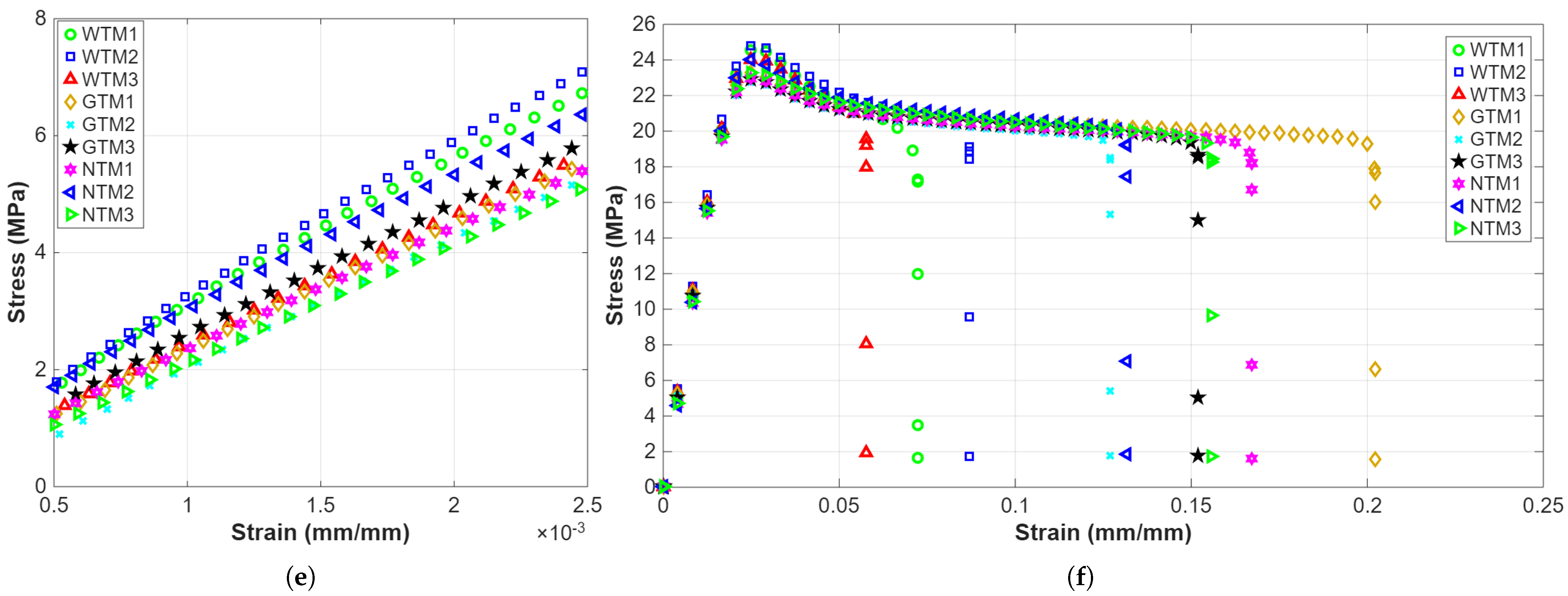
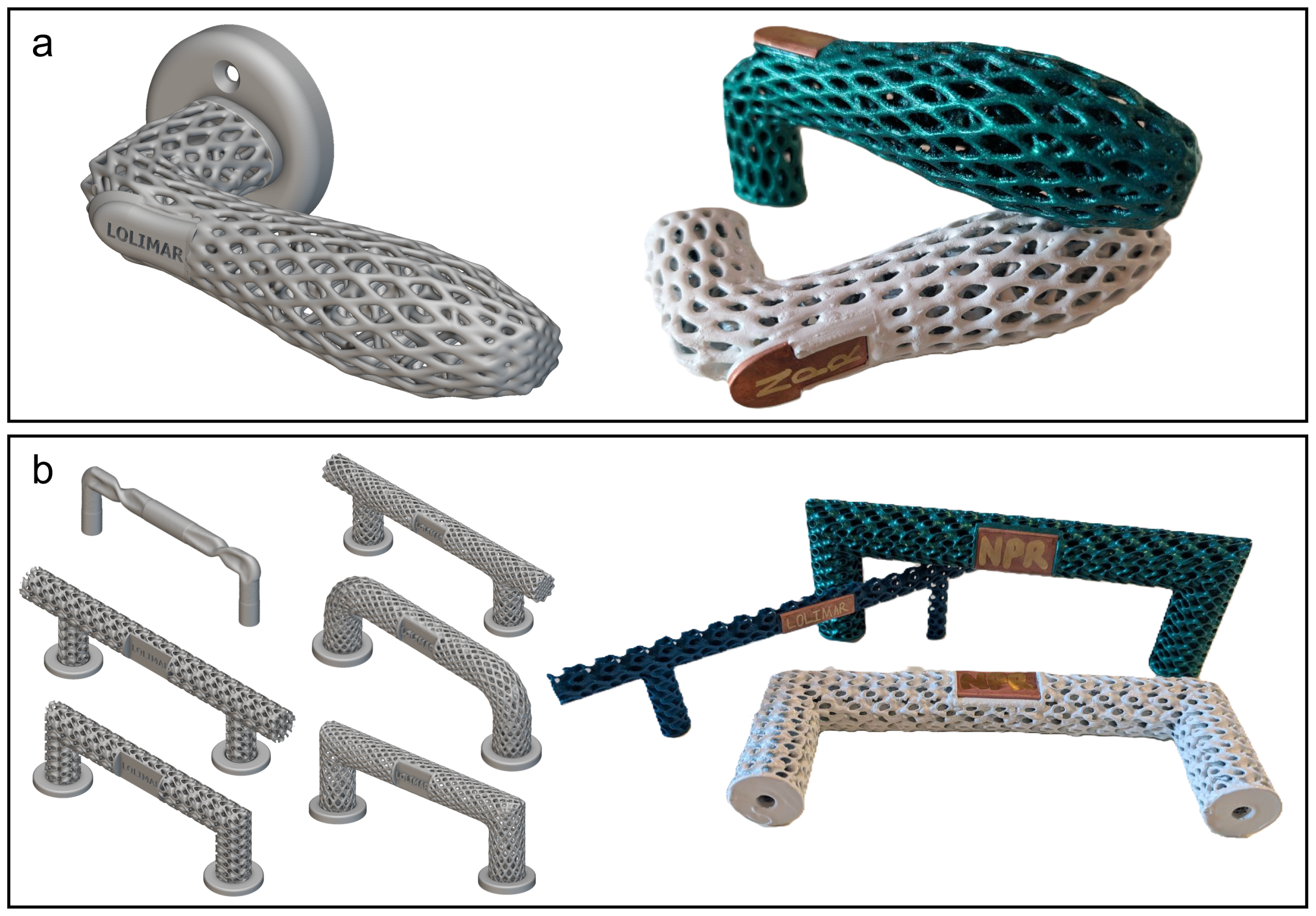
| Material | E, GPa | Yield, MPa | UTS, MPa | Density, g/cm3 | Elongation at Break, % | |
|---|---|---|---|---|---|---|
| PLA | 3.5 | 0.36 | 70 | 73 | 1.25 | 7 |
| Parameters | Uncoated | Green | White | ||||||
|---|---|---|---|---|---|---|---|---|---|
| Ref | UVB | TM | Ref | UVB | TM | Ref | UVB | TM | |
| 81 | 82 | 82 | 40 | 40 | 40 | 94 | 94 | 95 | |
| −16 | −18 | −16 | −48 | −39 | −48 | −2 | −1 | −1 | |
| −13 | −6 | −11 | 12 | 9 | 11 | 2 | 3 | 3 | |
| - | −1 | −1 | - | 0 | 0 | - | 0 | −1 | |
| - | 2 | 0 | - | −9 | 0 | - | −1 | −1 | |
| - | −7 | 2 | - | 3 | 1 | - | −1 | −1 | |
| - | 7.3 | 2.2 | - | 9.5 | 1 | - | 1.4 | 1.7 | |
| Elastic Modulus, GPa | |||||||
|---|---|---|---|---|---|---|---|
| Sample | NTT | NUVB | GUVB | WUVB | NTM | GTM | WTM |
| 1 | 2.28 | 1.41 | 1.26 | 1.36 | 2.10 | 2.16 | 2.54 |
| 2 | 2.43 | 1.34 | 1.33 | 1.42 | 2.35 | 2.22 | 2.67 |
| 3 | 2.30 | 1.33 | 1.29 | 1.39 | 2.05 | 2.26 | 2.19 |
| 4 | 2.34 | - | - | - | - | - | - |
| 5 | 2.23 | - | - | - | - | - | - |
| Mean | 2.32 | 1.36 | 1.29 | 1.39 | 2.17 | 2.21 | 2.47 |
| S.D. | 0.07 | 0.04 | 0.03 | 0.03 | 0.16 | 0.05 | 0.25 |
| Tensile Strength at Yield or Yield Stress, MPa | |||||||
| Sample | NTT | NUVB | GUVB | WUVB | NTM | GTM | WTM |
| 1 | 24.7 | 23.9 | 23.8 | 25.2 | 23.0 | 23.3 | 24.6 |
| 2 | 24.6 | 23.1 | 23.7 | 25.4 | 24.0 | 22.8 | 24.8 |
| 3 | 24.4 | 23.1 | 23.9 | 25.2 | 23.3 | 22.9 | 24.1 |
| 4 | 24.4 | - | - | - | - | - | - |
| 5 | 23.8 | - | - | - | - | - | - |
| Mean | 24.4 | 23.4 | 23.8 | 25.3 | 23.4 | 23.0 | 24.5 |
| S.D. | 0.3 | 0.5 | 0.1 | 0.1 | 0.5 | 0.3 | 0.4 |
| Tensile Strength at Break, MPa | |||||||
| Sample | NTT | NUVB | GUVB | WUVB | NTM | GTM | WTM |
| 1 | 16.7 | 14.9 | 19.5 | 21.6 | 16.7 | 16.0 | 17.2 |
| 2 | 16.1 | 15.1 | 19.4 | 20.6 | 17.5 | 15.3 | 18.4 |
| 3 | 16.2 | 15.0 | 18.8 | 16.4 | 18.3 | 15.0 | 18.0 |
| 4 | 14.4 | - | - | - | - | - | - |
| 5 | 13.5 | - | - | - | - | - | - |
| Mean | 15.4 | 15.0 | 19.2 | 19.5 | 17.5 | 15.4 | 17.9 |
| S.D. | 1.4 | 0.1 | 0.4 | 2.8 | 0.8 | 0.5 | 0.6 |
| Elongation at Break, % | |||||||
| Sample | NTT | NUVB | GUVB | WUVB | NTM | GTM | WTM |
| 1 | 35.2 | 7.7 | 11.4 | 3.9 | 16.7 | 20.2 | 7.2 |
| 2 | 44.1 | 8.2 | 11.2 | 4.8 | 13.2 | 12.7 | 8.7 |
| 3 | 55.6 | 7.6 | 11.9 | 4.3 | 15.6 | 15.2 | 5.8 |
| 4 | 35.4 | - | - | - | - | - | - |
| 5 | 41.4 | - | - | - | - | - | - |
| Mean | 42.3 | 7.8 | 11.5 | 4.3 | 15.2 | 16.0 | 7.2 |
| S.D. | 8.4 | 0.3 | 0.4 | 0.5 | 1.8 | 3.8 | 1.5 |
| Design Parameters | Lever | Pull |
|---|---|---|
| , mm | 50 | 375 |
| , mm | 200 | 60 |
| , mm | - | 250 |
| , mm | - | 62.5 |
| , mm | 20 | 25 |
| , mm | 20 | 25 |
| , mm | 15 | 17.5 |
| , mm | 30 | 35 |
| , mm | 10 | 17.5 |
| , mm | 20 | 35 |
| Rotation under the load, , mm | 12.6 | 33.1 |
| Rotation under the load, , mm | 10.7 | 25.2 |
| Mass (), g | 78 | 304 |
| Mass (), g | 98 | 379 |
Disclaimer/Publisher’s Note: The statements, opinions and data contained in all publications are solely those of the individual author(s) and contributor(s) and not of MDPI and/or the editor(s). MDPI and/or the editor(s) disclaim responsibility for any injury to people or property resulting from any ideas, methods, instructions or products referred to in the content. |
© 2025 by the authors. Licensee MDPI, Basel, Switzerland. This article is an open access article distributed under the terms and conditions of the Creative Commons Attribution (CC BY) license (https://creativecommons.org/licenses/by/4.0/).
Share and Cite
Gebre, N.M.; Gallo, P.; Rossi, S. Design for Sustainability by Additive Manufacturing: A Study of PLA-Based Door Handle Redesign. Sustainability 2025, 17, 4969. https://doi.org/10.3390/su17114969
Gebre NM, Gallo P, Rossi S. Design for Sustainability by Additive Manufacturing: A Study of PLA-Based Door Handle Redesign. Sustainability. 2025; 17(11):4969. https://doi.org/10.3390/su17114969
Chicago/Turabian StyleGebre, Nikodmose Moges, Pasquale Gallo, and Stefano Rossi. 2025. "Design for Sustainability by Additive Manufacturing: A Study of PLA-Based Door Handle Redesign" Sustainability 17, no. 11: 4969. https://doi.org/10.3390/su17114969
APA StyleGebre, N. M., Gallo, P., & Rossi, S. (2025). Design for Sustainability by Additive Manufacturing: A Study of PLA-Based Door Handle Redesign. Sustainability, 17(11), 4969. https://doi.org/10.3390/su17114969







